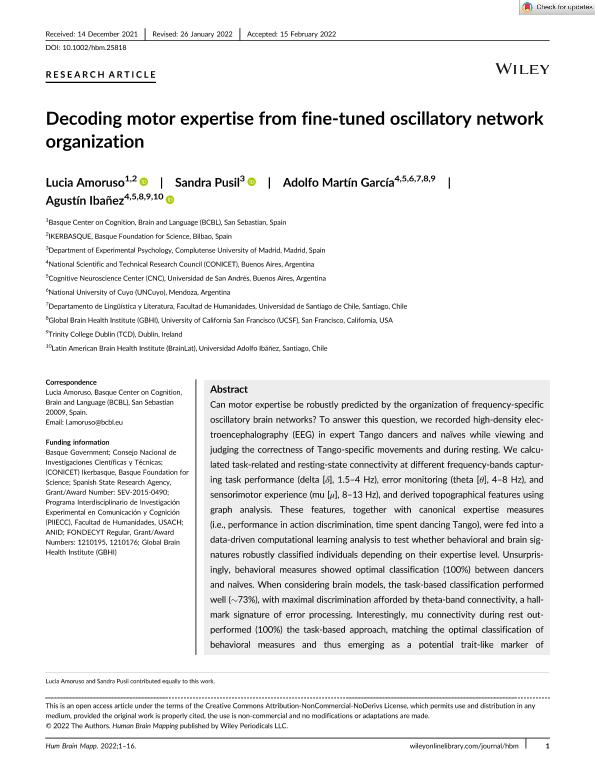Mostrar el registro sencillo del ítem
dc.contributor.author
Amoruso, Lucía

dc.contributor.author
Pusil, Sandra
dc.contributor.author
García, Adolfo Martín

dc.contributor.author
Ibañez, Agustin Mariano

dc.date.available
2023-02-08T14:17:48Z
dc.date.issued
2022-06
dc.identifier.citation
Amoruso, Lucía; Pusil, Sandra; García, Adolfo Martín; Ibañez, Agustin Mariano; Decoding motor expertise from fine-tuned oscillatory network organization; Wiley-liss, div John Wiley & Sons Inc.; Human Brain Mapping; 43; 9; 6-2022; 2817-2832
dc.identifier.issn
1065-9471
dc.identifier.uri
http://hdl.handle.net/11336/187300
dc.description.abstract
Can motor expertise be robustly predicted by the organization of frequency-specific oscillatory brain networks? To answer this question, we recorded high-density electroencephalography (EEG) in expert Tango dancers and naïves while viewing and judging the correctness of Tango-specific movements and during resting. We calculated task-related and resting-state connectivity at different frequency-bands capturing task performance (delta [δ], 1.5–4 Hz), error monitoring (theta [θ], 4–8 Hz), and sensorimotor experience (mu [μ], 8–13 Hz), and derived topographical features using graph analysis. These features, together with canonical expertise measures (i.e., performance in action discrimination, time spent dancing Tango), were fed into a data-driven computational learning analysis to test whether behavioral and brain signatures robustly classified individuals depending on their expertise level. Unsurprisingly, behavioral measures showed optimal classification (100%) between dancers and naïves. When considering brain models, the task-based classification performed well (~73%), with maximal discrimination afforded by theta-band connectivity, a hallmark signature of error processing. Interestingly, mu connectivity during rest outperformed (100%) the task-based approach, matching the optimal classification of behavioral measures and thus emerging as a potential trait-like marker of sensorimotor network tuning by intense training. Overall, our findings underscore the power of fine-tuned oscillatory network signatures for capturing expertise-related differences and their potential value in the neuroprognosis of learning outcomes.
dc.format
application/pdf
dc.language.iso
eng
dc.publisher
Wiley-liss, div John Wiley & Sons Inc.

dc.rights
info:eu-repo/semantics/openAccess
dc.rights.uri
https://creativecommons.org/licenses/by-nc-nd/2.5/ar/
dc.subject
ACTION OBSERVATION
dc.subject
BRAIN NETWORKS
dc.subject
GRAPH THEORY
dc.subject
HDEEG
dc.subject
MACHINE LEARNING
dc.subject
MOTOR EXPERTISE
dc.subject
RESTING-STATE
dc.subject.classification
Psicología

dc.subject.classification
Psicología

dc.subject.classification
CIENCIAS SOCIALES

dc.title
Decoding motor expertise from fine-tuned oscillatory network organization
dc.type
info:eu-repo/semantics/article
dc.type
info:ar-repo/semantics/artículo
dc.type
info:eu-repo/semantics/publishedVersion
dc.date.updated
2023-02-02T23:23:16Z
dc.journal.volume
43
dc.journal.number
9
dc.journal.pagination
2817-2832
dc.journal.pais
Estados Unidos

dc.journal.ciudad
New York
dc.description.fil
Fil: Amoruso, Lucía. Consejo Nacional de Investigaciones Científicas y Técnicas; Argentina
dc.description.fil
Fil: Pusil, Sandra. Universidad Politécnica de Madrid; España
dc.description.fil
Fil: García, Adolfo Martín. Universidad de San Andrés; Argentina. Universidad Nacional de Cuyo. Facultad de Educación Elemental y Especial; Argentina. Consejo Nacional de Investigaciones Científicas y Técnicas; Argentina. Universidad de Santiago de Chile; Chile. University of California; Estados Unidos
dc.description.fil
Fil: Ibañez, Agustin Mariano. Universidad de San Andrés; Argentina. University of California; Estados Unidos. Universidad Adolfo Ibañez; Chile. Consejo Nacional de Investigaciones Científicas y Técnicas; Argentina
dc.journal.title
Human Brain Mapping

dc.relation.alternativeid
info:eu-repo/semantics/altIdentifier/url/https://onlinelibrary.wiley.com/doi/10.1002/hbm.25818
dc.relation.alternativeid
info:eu-repo/semantics/altIdentifier/doi/https://doi.org/10.1002/hbm.25818
Archivos asociados
